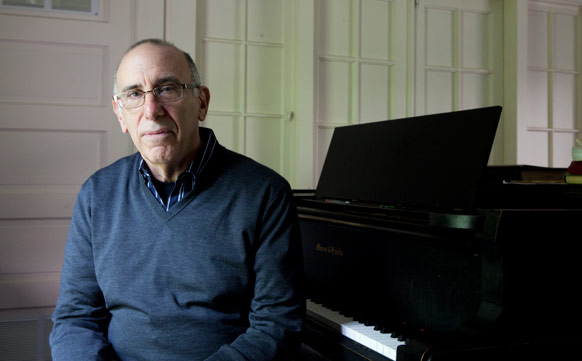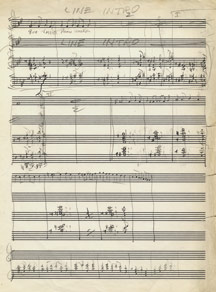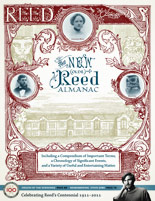
IRIS login | Reed College home Volume 90, No. 4: December 2011
Such Sweet Thunder (continued)

Professor David Schiff [music 1980–] Photo by Vivian Johnson

Professor David Schiff [music 1980–] trembled when he unearthed Ellington’s original sketches for
“The Second Line,” (opposite) in the Smithsonian’s archives.
Duke Ellington Collection, Archives Center, National Museum of American History, Smithsonian Institution.
When Schiff matriculated at Columbia University, to begin working toward a PhD in English, he expanded his cultural adventures, now delving into Manhattan’s happening jazz scene. He caught Miles Davis live at Fillmore East, took in James Brown at the Apollo Theater, and Theolonius Monk at the Five Spot. When he went away to Cambridge in 1967 on a fellowship, he still homed in on jazz, now listening to Count Basie and Louis Armstrong on BBC Radio.
At age 27, Schiff shifted his career path and entered Juilliard to study classical composition. His first piece was an opera, Gimpel the Fool, based on an Isaac Bashevis Singer short story about a beleaguered baker. Joyously surreal, Gimpel is steeped in Jewish motifs and features the memorable line, “The rabbi gave birth to a calf.” Schiff says that, in writing the opera, he was channeling the jazz inflections in the music of Russian composer Igor Stravinsky. Later, all the jazz music he’d heard in his formative days caused him to pepper his steady outpouring of classical compositions with a few straight jazz pieces. He wrote Shtik (1992) for a jazz quintet and Low Life (1998) for a big, Ellington-style jazz band.
Meanwhile, he also wrote about jazz, with an ardor for kicking up dust. In 1991, in a New York Times column about the revival in “Golden Age” symphonies from the ’30s, he dissed these “waterlogged vessels” and urged readers to tune in, instead, to ’30s-era black swing artists such as Ellington, Fletcher Henderson, and Chick Webb. In a 1995 Atlantic piece, he argued that Ellington and Stravinsky were aesthetic brethren, as they both built music in a cubist manner by cobbling together “complicated, dense and disorienting” phrases.
He was, it seems, already drafting his new book in his mind.
The principal thesis of The Ellington Century is that in American music of the 1900s the walls between genres were unnecessary, and erected by fussy, uptight music snobs who wanted to ghettoize jazz. The century’s lifeblood lay, he believes, in cross-pollination. “Leonard Bernstein jammed (once) with Miles Davis,” Schiff writes. “Frank Zappa worshipped the music of Edgard Varèse. [But] no single oeuvre represents the full cross-categorical range of mid-20th century music more than the vast repertory, mainly composed by Ellington and Strayhorn, of the Duke Ellington Orchestra. This rich body of music, written over nearly 50 years, includes enduring songs, instrumental tone parallels, jazz concertos, extended suites, ballet music, film music, sacred music.”
Schiff’s stance is inherently political, for it demands us to consider more than the snappy, catchy songs that made Ellington famous early on, when he was playing what white fans called “jungle music” at the Cotton Club in Harlem. These tunes were all three minutes and 12 seconds long, at most. They were crafted to fit on a 78-rpm record, and in time Ellington grew beyond them and became, controversially, more ambitious, more expansive. In 1943, for instance, he produced Black, Brown and Beige, a 45-minute, three-part orchestral piece that endeavored to capture the whole sweep of African American history, from slavery to post–World War II Harlem, largely through tonally varied instrumental pieces. In the last decade of his life, he wrote three Sacred Concerts, which mixed ethereal vocals with frolicsome tap dancing and ultimately, in a 1973 concert, brought soulful jazz into the lofty nave of Westminster Abbey in London.
John Hammond, the vaunted midcentury music critic and producer, griped that, in changing his act, Ellington “has introduced complex harmonies solely for effect.” Many subsequent critics have likewise dismissed Ellington’s later stuff, but Schiff sees the bandleader as relevant throughout—and in the thick of the 20th century’s most vexing cultural debates. In discussing a driving 1957 instrumental, “Such Sweet Thunder,” inspired by Shakespeare’s Othello, he relates how Ellington always told audiences about “all the fun” that the black king and his beloved, fair Desdemona had together. “With its brash, brazen, brassy opening,” Schiff argues, the piece didn’t simply retell Shakespeare in an African American idiom. It “challenged the era’s official culture of sexual repression. . . . In the third chorus, the ‘jungle’ speaks, gently, in the form of a nonchalant trumpet solo.”
The Ellington Century doesn’t try to be a comprehensive Ellington biography. It is, rather, a medley of eight essays, each presented as a chapter whose title hints at a musical motif. There is “Color,” for instance, and “Rhythm,” and “Melody.” While each essay sets Ellington’s songs in a sociopolitical context, it’s engaged primarily with close musical analysis, so that in “Color,” Schiff explores what he calls “Ellington’s gift for translating visual colors into tone colors” by dwelling on how one 1938 tune, “Blue Light,” uses “meditative bell-like chords on the piano” to suggest “the indigo atmosphere of the last set in some nearly deserted nightclub.” He outlines the song’s score—“piano solo 4 bars, Chorus I . . . ”—and then lets Ellington describe how he mainly learned blues in the street: “I went on with studying, of course, but I could also hear people whistling, and I got all the Negro music that way. You can’t learn that in any school.”
As he researched his book, Schiff listened to some Ellington songs over 100 times, and he so savored the music—now frantic and light on its feet, and now slow and majestic and regal—that he realized that part of him had always yearned to be a jazz composer. “But if you think of the list of people who’ve been jazz composers it has about two people on it, Duke Ellington and Charles Mingus,” he says. “It didn’t seem like there was a place in music for a jazz composer.”
For many years, Schiff says, he tried to satisfy his jazz craving as many classical composers do, by “importing colors and elements from jazz.” That didn’t work, exactly. “The standard approach,” Schiff says, “is to treat the jazz as though it’s just icing on the cake. The assumption is that classical has a monopoly on technique. I’ve questioned that idea for a long time.”
And on a recent Thursday morning, it seemed that perhaps Ellington had perhaps set Schiff free from his angst. It was gray and cool outside, and as Schiff shuffled about in his third-floor Prexy office, he fielded the odd email from Seattle. That night, the Seattle Symphony was performing a new David Schiff piece, a three-minute tribute to the Symphony’s longtime music director, Gerard Schwarz, who was retiring. Schwarz was once a trumpeter, and so Schiff’s piece was a snappy salsa number starring a trumpet. It drew very little from the gods of classical music. “Ellington,” Schiff explained, “was the master of the three-minute piece. He provided the formal model for me, and there’s even a few trumpet licks that I lifted straight from ‘Lady Mac,’” a late Ellington song.
Schiff scat-sang the stolen riff—badapapabadapapabadapapa. Then he rolled his head back for a moment, delighted. In a few hours, the symphony would be playing his new piece, and the music of Duke Ellington would live once more, reinvented, far from the ballrooms of Harlem.
- Previous Page
- 1
- 2
- Next Page


LATEST COMMENTS
steve-jobs-1976 I knew Steve Jobs when he was on the second floor of Quincy. (Fall...
Utnapishtim - 2 weeks ago
Prof. Mason Drukman [political science 1964–70] This is gold, pure gold. God bless, Prof. Drukman.
puredog - 1 month ago
virginia-davis-1965 Such a good friend & compatriot in the day of Satyricon...
czarchasm - 4 months ago
John Peara Baba 1990 John died of a broken heart from losing his mom and then his...
kodachrome - 7 months ago
Carol Sawyer 1962 Who wrote this obit? I'm writing something about Carol Sawyer...
MsLaurie Pepper - 8 months ago
William W. Wissman MAT 1969 ...and THREE sisters. Sabra, the oldest, Mary, the middle, and...
riclf - 10 months ago